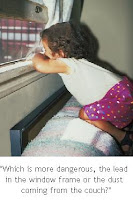Canadians may be exposed to a wide variety of metals, chemicals and pesticides on a daily basis as the result of a seemingly harmless domestic nuisance: house dust.
It's a potential health hazard that scientists are only beginning to understand.
Health Canada and the Public Health Agency of Canada have embarked on a landmark four-year national study to determine levels of metals and chemicals in house dust across the country, and how health risks should be addressed.
 Dust typically contains a variety of toxins released by common household products including plastics, electronics, furniture, garden soil and lead paint, which is common in older homes.
Dust typically contains a variety of toxins released by common household products including plastics, electronics, furniture, garden soil and lead paint, which is common in older homes.
Scientists don't know for sure where all the toxins commonly found in dust come from.
They also don't know the typical concentration of metals and other toxins in house dust.
Unlike lead paint on toys or chemicals in plastic, scientists say house dust presents a far greater, unique risk because the loose, free particles can be easily ingested by children crawling on the floor or may be inhaled when dust becomes airborne.
Research has linked lead, flame retardants and pesticides found in house dust with the accumulation of these toxins in children's bodies.
"We've found high levels of lead in house dust is associated with higher blood lead levels in kids," said Paul Lioy, director of the exposure science division of the Environmental and Occupational Health Sciences Institute, at jointly sponsored by Rutgers University and the University of Medicine and Dentistry of New Jersey.
"We don't know what typical concentrations are for metals in house dust and other substances," said Pat Rasmussen, research scientist at Health Canada and principal investigator of the national house dust study.
Read the rest of the story here


No comments:
Post a Comment